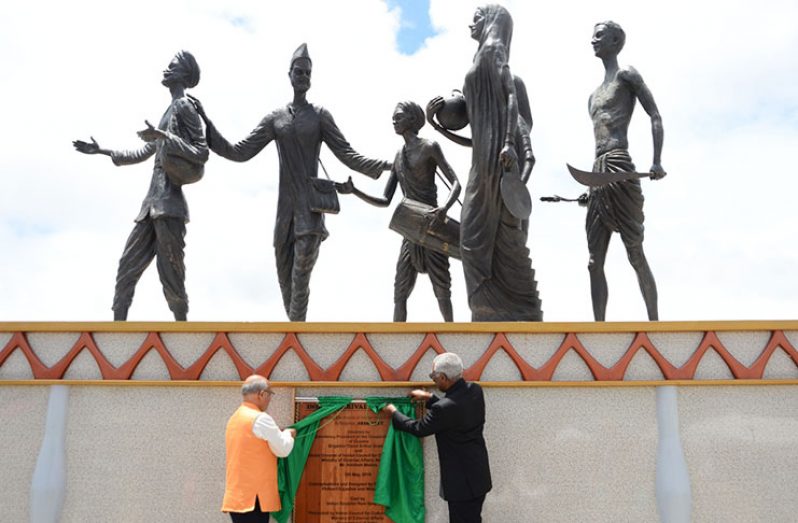— says President at commissioning of iconic Indian Arrival Monument
PRESIDENT David Granger has hailed the contributions of East Indians to the development of Guyana as significant as he commissioned the iconic Indian Arrival Monument at Palmyra, East Berbice, Corentyne, on Sunday.

The expressive artistic structure, which journeys back in time, overlooks a museum and verdant garden with fountain. The occasion coincided with the observance of Arrival Day. Arrival Day celebrates the contributions of African, Chinese, Portuguese, Amerindians, Europeans and East Indians to Guyana.
From a distance, the monument at T Junction, Palmyra, is noticeable. It is surrounded by the vast and lush canefields there. This location makes it stand out as a fitting tribute to the East Indians who came here some 181 years ago as indentured labourers to work on the sugar plantations.
Between 1838 and 1917, when the Indentureship System ended, some 240,000 Indians, drawn from the states of Uttar Pradesh, Bihar and Madras (now Tamil Nadu), came to these shores.
Addressing a gathering of diplomats, government ministers including Prime Minister Moses Nagamootoo, senior regional officials and residents, President Granger, a historian, related that seven out of every 10 immigrants who came opted to stay and make Guyana their homeland.

In doing so, he said they and their descendants contributed significantly to Guyana’s development.
“Indian contributions to the economy are unquestionable. Indians who began arriving even before the abolition of African enslavement in 1838 became, eventually, the main source of labour in the sugar and rice industries. They have helped to sustain these pillars of our economy for more than 180 years.
“Indian resourcefulness contributed, also, to the diversification of the rural economy through the development of cattle-rearing, cash crop and coconut cultivation, paddy-growing, rice-milling and fishing.
“Village economies and settlements — and their skills as bakers, boatmen, charcoal-burners, chemists, fishermen, goldsmiths, hucksters, milk and sweetmeat vendors, shopkeepers and tailors, skills they brought from India – helped to reshape the Guyanese rural, economic and social landscape,” the President said.
Indians became a considerable commercial and landowning class after they quit the plantations and some, through thrift and industry, became part of a thriving business élite.

Some opened new areas of production along the banks of rivers and creeks and in the islands of the Essequibo. Many acquired land and established villages and communities. Their economic enterprise expanded the economy and generated a demand for education and skills, said the President in praising their contributions.
From very humble beginnings, the immigrants toiled for a better life and President Granger pointed out that their descendants inspired by their struggles, have distinguished themselves in every field of human endeavour.
Many, he said, have excelled in academia, agriculture, accounting, the arts, business, diplomacy, education, engineering, law enforcement, legal services, medicine, military service, politics, the public service, sport and trade unionism.
The Indian Arrival Monument, he said, aptly honours the struggles, resilience and contributions of the Indians who came and projects an image of hope and optimism.
“This monument not only casts an eye backwards to our past and but can also help to advance towards a common future, a future for all of our peoples,” the Guyanese Head of State said.
It is a concrete reminder of the journeys of arrival and the continuing journey towards a society characterised by human dignity and material progress, he reminded while also noting that it represents a symbol of the migrants’ resistance and resourcefulness in pursuit of a good life.
“We are richer for their arrival and for their remaining here,” he said as he thanked the Government of India for its contribution and collaboration to see the monument to fruition.
A SHRINE
“This monument site is a shrine to Indian immigration and to the migrants’ adoption and adaptation to their new homeland,” the Guyanese leader contended.
Speaking generally, the President said Arrival Day commemorates the combination and culmination of events which led to the creation of Guyana.
And on that score, he emphasised that no nation can develop its full capacity unless it harnesses the potential of all its people and they all live harmoniously together.
“It is for this reason that we are pursuing the realisation of a cohesive state in which all of our people will be recognised and respected. A cohesive state is vital to ensuring a sustainable, safe and secure environment, one in which present and future generations can be happy. It is essential to protecting the legacy of past generations,” he said.
The East Berbice-Corentyne region, he noted, is a favourable location for these celebrations. It boasts a cosmopolitan population with large African, Amerindian and East Indian communities, along with persons of Chinese and European descent.
These are Guyana’s main ethnic groups of descendants who came from the Americas, Africa, Asia and Europe.
“Arrival Day celebrates the contributions of all of our peoples – Amerindians, Africans, Asians and Europeans. Our nation was established on the foundation of their sacrifices and achievements.
“Arrival Day recognises the nation’s diversity. It signifies the creation of a conglomeration of cultures. The nation is multicultural, and always will be and each culture enriches national integration despite differences in origin,” the President said.
At Highbury, Region Six, indentured immigrants first set foot in Guyana. At the expiration of their contracts, many choose to live in Region Six alongside other ethnic groups.
HARMONY
The abolition of Indian indentured immigration, the President said, intensified the migrants’ efforts to integrate more fully into Guyana’s multi-ethnic society since by then they already shared a common space with other ethnic groups with whom they had sought and enjoyed respectful relations.

He said the harmonious relations were aided by the religious and cultural conventions and practices of tolerance among ethnic groups which helped each group to make the most of this country’s economic opportunities.
“Guyanese, today, are heirs of this precious legacy of all of our African, Amerindian, Asian and European foreparents. The strands of the national tapestry are stronger because of these contributions.
“We must preserve this precious multi-cultural heritage by working together to secure a common future where all are recognised and respected and where everyone could enjoy this country’s bounty,” the President told the gathering.
Indian High Commissioner to Guyana, Venkatachalam Mahalingam who spoke earlier, said the location of the monument is most appropriate.
He noted that it is easily visible to persons crossing the Berbice Bridge into Region Six and persons leaving the region.
The ambassador, in praising the structure, hails it as a dedication to the Indian indentured servants who crossed the kala pani (black waters) to come here in search of a better life and contributed significantly to Guyana’s development.
India, he said, is committed to connecting with its diaspora and has been doing so through a variety of initiatives, including the Know India Programme.
Director-General of the Indian Council for Cultural Relations (ICCR) Akhilesh Mishra also spoke at the commissioning. Mishra, who came to Guyana for the special occasion, praised the warmth and hospitality he has received while here.

Bringing greetings from the Government of India and the 1.3 billion people there, he said the T Junction site has brought Guyana and India closer together.
He told the gathering that the ICCR, the cultural relations arm of India, holds Guyana in high regard, pointing out that this country is a model nation for cultural preservation.
There is a lot India can learn from Guyana as much as it can share in this regard, he said, pointing out that Guyana, being able to preserve its diverse cultures for generations, is both remarkable and worthy of emulation.
He also said India deeply values its friendship with Guyana and the commissioned monument is symbol of their mutual corporation, love and admiration.




.png)









